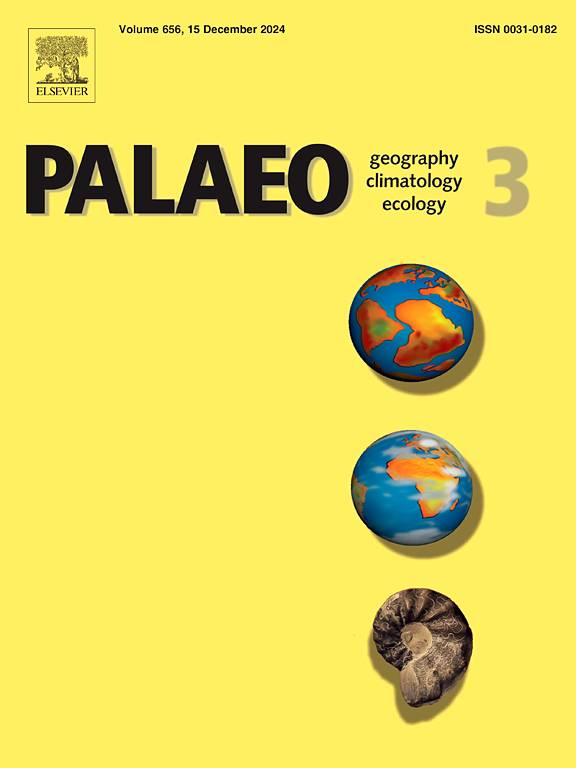特刊社论序言:显生宙全球气候变化期间生物钙化剂的恢复和响应
IF 2.7
2区 地球科学
Q2 GEOGRAPHY, PHYSICAL
Palaeogeography, Palaeoclimatology, Palaeoecology
Pub Date : 2025-06-22
DOI:10.1016/j.palaeo.2025.113106
引用次数: 0
摘要
通过显生宙,地球经历了几次环境扰动,其特征是不同的节奏和生态系统恢复和响应模式,分泌碳酸钙骨架(钙化剂)的生物尤其脆弱。这些事件偶尔会达到生态临界点,引发海洋钙化物丰度、生物多样性、生态范围和生物矿化过程的永久性变化。今天,底栖生物和浮游海洋钙化生物受到这些全球扰动的影响最大;因此,了解钙化物如何对近期和遥远的过去的全球气候和环境扰动作出反应,以了解未来的恢复能力是很重要的。本期虚拟特刊(VSI)题为《显生宙全球气候变化期间生物钙化剂的恢复和响应》,收录了17篇论文,记录了海洋钙化剂对全球压力的适应性反应,涉及地质记录和现代生物群的例子。论文跨度从二叠纪到近代,并考虑了上层生物,底栖生物,以及上层和底栖生态系统的综合研究。主要研究结果如下:(1)浮游生物群落比底栖生物群落表现出更强的生态恢复能力;(2)除了二叠纪末和三叠纪-侏罗纪边界危机导致生态系统崩溃和灭绝外,大多数扰动引发的是生态转移,而不是完全的生物翻转;(3)底栖生态系统经常通过重组形成新的群落组合来作出反应。需要强调的是,每个事件都代表了一个独特的案例研究,其中不同的持续时间和环境压力因素是决定生物生存和生态系统重构的关键因素。这些论文将有助于发现最脆弱和/或高度耐受和弹性的分类群,以便量化对当前气候变化的最常见反应和适应策略。本文章由计算机程序翻译,如有差异,请以英文原文为准。
Editorial preface to special issue: Biocalcifier resilience and response during Phanerozoic global climate changes
Through the Phanerozoic, the Earth has experienced several environmental disturbances characterised by varied tempos and modes of ecosystem resilience and response, and organisms that secrete calcium carbonate skeletons (calcifiers) have been especially vulnerable. These events have occasionally reached ecological tipping points, triggering permanent changes in the abundance, biodiversity, ecological range and biomineralization processes of marine calcifiers. Today benthic and planktic marine calcifiers are most impacted by these global perturbations; therefore, it is important to understand how calcifiers responded to global climatic and environmental perturbations in the recent and distant past in order to understand future resilience. This Virtual Special Issue (VSI), entitled Biocalcifier resilience and response during Phanerozoic global climate changes, comprises 17 papers that document the adaptative response of marine calcifiers to global stresses, dealing with examples from the geological record and from modern biota. Papers span from the Permian to the Recent, and consider pelagic organisms, benthic organisms, and integrated studies of pelagic and benthic ecosystems. Some of the main findings are as follows: (1) Planktic communities show a greater ecological resilience than benthic ones; (2) Most perturbations trigger ecological shifts rather than complete biotic turnovers, the exceptions being the end-Permian and Triassic-Jurassic boundary crises which led to ecosystem collapse and extinctions; and (3) Benthic ecosystems often respond through reorganization into new community assemblages. It is important to emphasise that each event represents a unique case study, where different duration and environmental stressors are key factors in determining organismal survival and ecosystem restructuring. The papers presented will be of help in detecting the most vulnerable and/or highly tolerant and resilient taxa in order to quantify the most common responses and adaptive strategies to current climate changes.
求助全文
通过发布文献求助,成功后即可免费获取论文全文。
去求助
来源期刊
CiteScore
5.90
自引率
10.00%
发文量
398
审稿时长
3.8 months
期刊介绍:
Palaeogeography, Palaeoclimatology, Palaeoecology is an international medium for the publication of high quality and multidisciplinary, original studies and comprehensive reviews in the field of palaeo-environmental geology. The journal aims at bringing together data with global implications from research in the many different disciplines involved in palaeo-environmental investigations.
By cutting across the boundaries of established sciences, it provides an interdisciplinary forum where issues of general interest can be discussed.

 求助内容:
求助内容: 应助结果提醒方式:
应助结果提醒方式:


